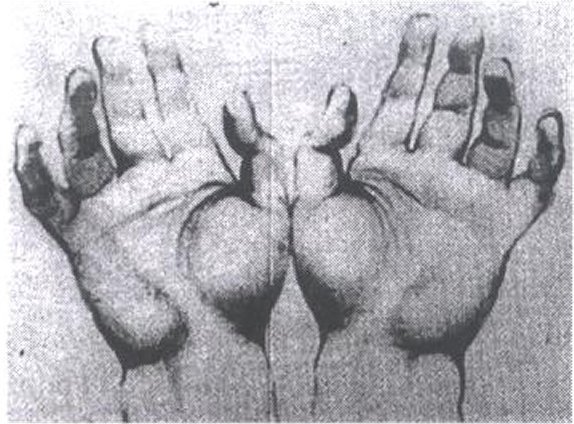|
Symmetry as the organization principle of artwork and its esthetic meaning
In this chapter we will attempt to identify the reasons for the occurrence and presence of symmetry in all aspects of creation in art, taking into account the laws of the psychology of perception (Arnheim, 1971, 1985, 1990; Gombrich, 1979; Markovic, 1993). Exact construction laws in art The following works of art pertain to the beginning of the 20th century and illustrate, each in its own way, the principle of symmetry (Senechal, 1989): The Grip by S. Graziani (Fig. 9.1), Drawing Hands by M.C. Escher (Fig. 9.2) and Cathedral by A. Rodin (Fig. 9.3). Graziani's drawing The Grip shows the left and the right hand in natural mirror-symmetric position. However, besides this natural "mirror" which copies the left hand into the right, the presence of another mirror will not escape the eye of a careful observer: that which reflects the image of both palms. Escher's Drawing Hands also depict the left and the right hand which transcend the two-dimensional plane of the drawing and enter into three-dimensional space, linked by the suggestion of a 180° -axis rotation, building a kind of "perpetuum mobile". Then they again return to their plane from three-dimensional space, drawing one another. Unlike the intellectual agitation that the spectator experiences during an encounter with this ßpatial-temporal loop", A. Rodin's Cathedral exudes a sense of harmony, accord, warmth and discreet elegance, all of which are in complete accord with the title of the work. However, the real surprise for the viewer lies in the fact that both the depicted hands are in reality left hands - the left woman's and man's hand linked by a 180° rotation. The extraordinary noble beauty to this sculpture is the result of its rotational symmetry. These three examples illustrate the limitlessness of the artist's imagination under strictly assigned ascetic circumstances: an identical theme - hands, and the same "rules of the game" - the application of the simplest forms of symmetry. By using symmetry as a means (not a goal), at the same time these examples represent an antithesis to the demands for unlimited freedom of art creativity and the a negation of rigid construction rules.
Figure 9.1 S. Graziani, The Grip.
Figure 9.2 M.C. Escher, The Drawing Hands.
Figure 9.3 A. Rodin, Cathedral.
|





